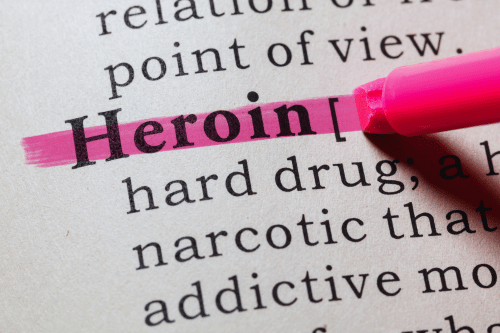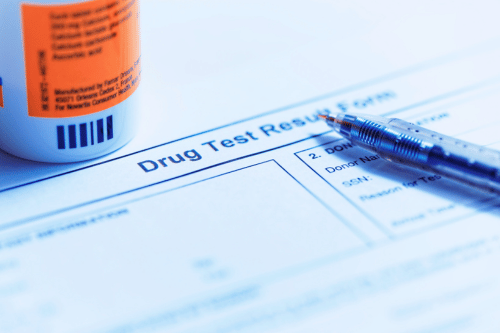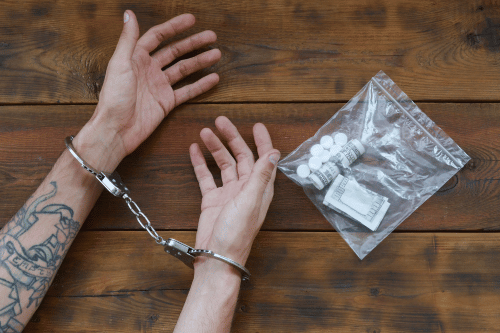

Heroin is a dangerous drug with a rapid onset and short half-life. Understanding how long heroin stays in the body helps people recognize the urgency of treatment and the need for professional help. Drug tests like urine tests, blood tests, and hair tests can detect heroin over different periods of time depending on various individual factors.
Heroin is an illicit opioid made from the poppy plant. It belongs to a group of addictive substances that cause intense euphoria followed by sedation. Due to its addictive nature, heroin use disorder can develop quickly with repeated use.
Heroin hijacks the brain’s reward system, which increases the risk of addiction. Over time, people need more heroin to feel the same effects, raising the risk of overdose. Many people start using heroin after misusing prescription opioids.
This transition often happens when access to opioid drugs becomes limited or expensive. As heroin is cheaper and more accessible on the street, it becomes a substitute with far greater health risks.
The time heroin stays in the body depends on the metabolism rate, body fat, body size, and hydration levels. Other factors include age, medical conditions, kidney health, and whether someone is a chronic user. Faster metabolism leads to shorter detection windows, but heroin’s half-life remains relatively short.
The average half-life of heroin is 30 minutes. However, its main metabolite, morphine, can linger longer in bodily fluids, especially in urine and saliva.

Heroin detection times vary based on the types of drug tests used. Urine testing is the most common method and can detect heroin use for 1 to 4 days. Blood tests detect heroin for only 5 to 6 hours after use, while saliva tests show heroin for up to 24 hours.
Hair follicle tests offer the longest detection window. Heroin can be found in hair follicles for up to 90 days after last use. This makes hair tests useful in identifying long-term heroin users.
Each test varies in sensitivity and reliability, and results may be influenced by factors like frequency of use and dosage. For chronic users or those with slower metabolism, heroin and its metabolites may remain detectable even longer than the average range. Understanding these timelines is important when evaluating recent or past heroin use in a treatment or testing setting.
Detection times are influenced by individual factors such as body mass, hydration levels, metabolic rate, and existing medical conditions. Kidney disease or liver issues can slow heroin clearance. Chronic users tend to store more heroin byproducts in body fat, extending detection time.
A larger body size may dilute heroin metabolites more quickly, but this isn’t always the case. Overall, the detection period of time can range from hours to months based on these variables.
Urine tests are the most widely used for identifying recent heroin use. Heroin in urine typically shows up within 2 hours and can stay detectable for 2 to 3 days. For chronic users, detection may extend up to a week.
Urine testing is non-invasive and cost-effective. It detects morphine, the key metabolite of heroin, which provides reliable results even after heroin’s half-life ends.
Blood tests are less common but offer precise results. They are often used in emergency situations or by medical professionals monitoring a patient’s health status. Heroin in the bloodstream disappears within a few hours due to its fast metabolism.
Despite the short detection window, blood tests can confirm recent heroin use. These tests are useful for evaluating heart rate, signs of overdose, or interactions with other opioid drugs. They can also help assess medical conditions related to heroin use, such as kidney disease or liver strain, during the early stages of treatment.
Saliva tests provide fast results and are easy to administer. Heroin can be detected in saliva within 30 minutes of use and remains for up to 24 hours. Saliva testing is growing in popularity due to its simplicity.
However, the shorter detection period makes saliva tests less useful for tracking long-term or past heroin use. They are often used in roadside or workplace testing situations. Saliva tests are non-invasive and can be helpful during early intervention or routine screening in outpatient settings like Sullivan Recovery.

Hair follicle tests are used to detect heroin over an extended period. Heroin can be found in hair for up to 90 days, making it useful for identifying chronic users. These tests examine hair follicles for drug traces embedded as the hair grows.
The results of hair tests depend on hair length and cleanliness. Hair tests are less affected by hydration levels, body size, or metabolic rate compared to urine tests or blood tests.
Heroin stays longer in people with higher body fat. That’s because heroin metabolites bind to fatty tissue, which slows elimination. Body mass and body size also affect how quickly the body processes drugs.
A person with a faster metabolism will eliminate heroin more quickly. However, chronic users or people with a slower metabolism may retain heroin longer, increasing detection windows and withdrawal symptoms. Hydration levels also influence how fast heroin is flushed out of the body, making water intake a small but notable factor in elimination speed.
Certain medical conditions can delay heroin elimination. Kidney disease reduces the body’s ability to clear morphine, extending heroin’s presence in bodily fluids. Liver issues may also impair drug breakdown.
People with chronic health risks face greater danger during detox and should seek medical detox. At Sullivan Recovery, our outpatient program helps monitor withdrawal symptoms and provides medical support throughout the recovery journey. Medical professionals also assess how conditions like heart problems or respiratory issues may impact the safety of the withdrawal process.
Black tar heroin is a sticky form of heroin commonly used in the western United States. It shares similar effects and half-life with white powder heroin. However, it may contain impurities that slow metabolism and increase health risks.
Detection times for black tar heroin are the same as for other types. Urine testing can reveal use within days, while hair tests can show use within months.

Heroin’s rapid onset increases the risk of overdose, especially when combined with synthetic opioids. The long-term effects of heroin use include liver damage, heart infections, and cognitive decline.
As heroin continues to damage the body, withdrawal symptoms grow more severe. These symptoms often resemble the flu and include vomiting, chills, and sweating. Heroin withdrawal symptoms usually begin within 6 to 12 hours after the last dose.
Heroin addiction develops quickly due to the drug’s psychological dependence. When someone stops using, withdrawal symptoms often require professional treatment. Flu-like symptoms, anxiety, and restlessness can make quitting hard without help.
At Sullivan Recovery, we help clients through the withdrawal process with medical detox and behavioral therapies. Each treatment plan is customized based on medical conditions, mental health condition, and drug use history.
Effective treatment programs combine behavioral therapies with holistic therapy. Cognitive-behavioral therapy (CBT) and group counseling help individuals rebuild daily routines and address triggers. These therapies also target co-occurring mental health conditions.
Holistic therapy may include yoga, nutrition planning, or exercise. These approaches support recovery by improving body awareness and reducing cravings.

At Sullivan Recovery in Mission Viejo, we offer an intensive outpatient program for heroin addiction. Our approach to treatment is structured to address heroin use disorder while allowing clients to stay at home.
Outpatient treatment gives flexibility while still offering professional care. Clients work with medical professionals to manage withdrawal symptoms and build long-term recovery skills.
Heroin is a powerful and addictive substance that requires more than willpower to quit. A professional treatment program increases the chance of lasting recovery. It provides structure, safety, and support throughout each stage of healing.
Medical detox is the first step in treating heroin addiction. After detox, therapy and aftercare help people stay on track during their recovery journey.
To summarize, heroin leaves the bloodstream quickly, but its effects linger. The life of heroin in the body is short, but its impact can be long-lasting. Accurate drug tests, including urine, blood, saliva, and hair tests, help determine the time heroin has been used.
If you or a loved one is struggling with heroin use, Sullivan Recovery is here to help. Our outpatient drug and alcohol treatment program offers evidence-based care tailored to your needs.
1. Indiana Department of Child Services – Drug Detection Times
https://www.in.gov/dcs/files/drug_detection-times_001_0220_FINAL.pdf
2.National Institute on Drug Abuse (NIDA) – Effects of Heroin on the Body
https://nida.nih.gov/publications/research-reports/heroin/effects-of-heroin-on-body
3. NIDA – Long-Term Effects of Heroin Use
https://nida.nih.gov/publications/research-reports/heroin/what-are-long-term-effects-heroin-use
4. DEA – Heroin Factsheet
https://www.dea.gov/factsheets/heroin
At Sullivan Recovery, as an in-network provider we work with most insurance plans, such as:
And More
If you or a loved one are struggling with mental health challenges or substance abuse, reach out to Sullivan Recovery today. Our team of compassionate professionals is here to support your journey towards lasting well-being. Give us a call at 949-836-7180.
No, secondhand exposure to heroin smoke is not likely to result in a positive drug test. Drug tests are designed to detect active metabolites at measurable levels that occur only through direct use. Passive contact does not produce enough concentration to trigger a positive result.
While physical activity may slightly boost metabolic rate, it does not significantly shorten heroin detection time. The liver and kidneys are primarily responsible for heroin elimination. Exercise cannot override the body’s natural detox process or replace medical detox in treatment.
Increased hydration may help dilute urine but won’t eliminate heroin or its metabolites more quickly. Overhydration can even lead to invalid test results. The most effective and safe way to clear heroin from the body is under medical supervision.
No, over-the-counter detox kits do not reliably remove heroin from the body or guarantee a clean test. Many products are unregulated and ineffective. Attempting to cheat a drug test can lead to serious legal or employment consequences and delay proper treatment.